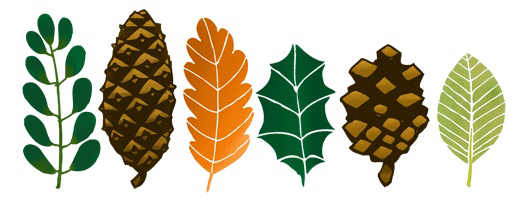 illustration: Matt Sewell
illustration: Matt Sewell
Words by Emma Warren.
I am in the middle of one of England’s largest pine forests and I literally can’t see the wood for the trees. That’s mostly because I’m hurtling through Bedgebury Pinetum in Kent on the red mountain bike run and if I move my concentration from the obstacle-lined path in front of me for even a millisecond I risk extreme injury.
Mountain-biking wasn’t really the plan today, but I’ve come with someone for whom danger and fun are naturally linked and before I knew it I was cycling around tracks that look like sideways log flumes, a kind of mud-lined velodrome with added plank bridges, protruding root trip-ups and drops that make me swear repeatedly. It’s one epic, pine-swooshed argggghhhhhhhhhhhhhhhhhhhhhh.
I’d never liked pines too much (see my previous column about murdering Leylandii) but I see lovely things once we reached the end of the trail. Red blush pines, others with short stocky cones standing up on branches like candles and trees with flat leaves like seaweed, or samphire, which my new Dorling Kindersly tree guide (thanks Mum) reveals to be a type of cypress.
A few weeks later I’m at a garden centre in Eltham, just at the point where London concrete morphs into field. I’m trying to work out why my damson tree is dying and how I managed to kill not one but two cherry trees. The irony. I start a column about trees. I buy fruit trees. And then, systematically, I kill them. The death-toll is stacking up and now includes the aforementioned cherries and a nectarine tree that shrivelled up and died after I moved it from a pot to a patch of crappy soil on the side of my house. Actually, it’s not really soil. It’s building hardcore with a few centimetres of soil on top, so no CSI required for that particular inquest.
Turns out the cherries and the damson suffered for similar reasons. They’re planted in squares of soil in my back yard. These squares previously housed the bastard Leylandii who continue to haunt me over a year after their removal. It turns out Leylandii are extremely thirsty trees and frequently drain all the nutrients out of the soil they’re planted in and my trees are basically malnourished. I am sent off with treated horse manure and orders to drench the tree in water until the ground rehydrates.
I’m just about to leave when I see a small tree in a pot. I turn the label so I can read the name: Fagus sylvatica. Beech! I know it without even checking. Woo. I can tell I’ve come a long way when the latin names for trees rotate in my head like a piece of modernist poetry. Fagus sylvatica. Betula pendular. Quercus robur. I can tell a pin oak from an English Oak and I can now recognise Ash, all tall and slender, swish-swashing, a pot of dill expanded into tree form.
I’ve had a few more eureka moments. My friends Chris and Annette live in a ’60s house round the back of Deptford High Street and there was a tree at the end of their street that I couldn’t figure out. I apologise to them, by the way, for dragging specimens inside and then leaving them by the computer (which was no help at all). Tree looked exotic. Farway. It had a diffused movement and elegance, almost blurry around the edges. It took me a while but eventually I got it. Chinese Scholar Tree! Even got a little buzz when I saw my next ones, a pair in Victoria Park on the walk towards the canal.
My dalliance with trees continues to be predominantly local. I’ve watched daily as the planes and limes on my south east London street struggled to push up new shoots from their brutalised pollard nubs. Eventually, nearly nine months after the chop, new life begins to appear, like tiny birds on rocky outcrops. A few weeks later and the limes are dressed up and down in carnivalesque green bunting, as if a primary school class has stuck bunches of leaves up and down the trunk like fuzzy felt.
I hear my neighbour’s palm tree whisk in the wind. I see a bouquet of roses appear naturally half way up a pine tree just around the corner. I walk under the line of willow branches scooping over the path towards my friend’s house in Kidbrooke and I can touch the inside like a surfer inside a tunnel of a wave. It reminds me of the opening chapter of Roger Deakin’s Wildwood, where he describes walking in woods as like walking on the bottom of the ocean.
The damson survived. It offers one narky globe of fruit. Not quite enough for jam, but it’s alive. Maybe next year.
Emma will be a guest of ours at Festival No 6 on Sunday 15 September when she will be talking with Bob Stanley about his forthcoming book, Yeah Yeah Yeah: The Story of Modern Pop.